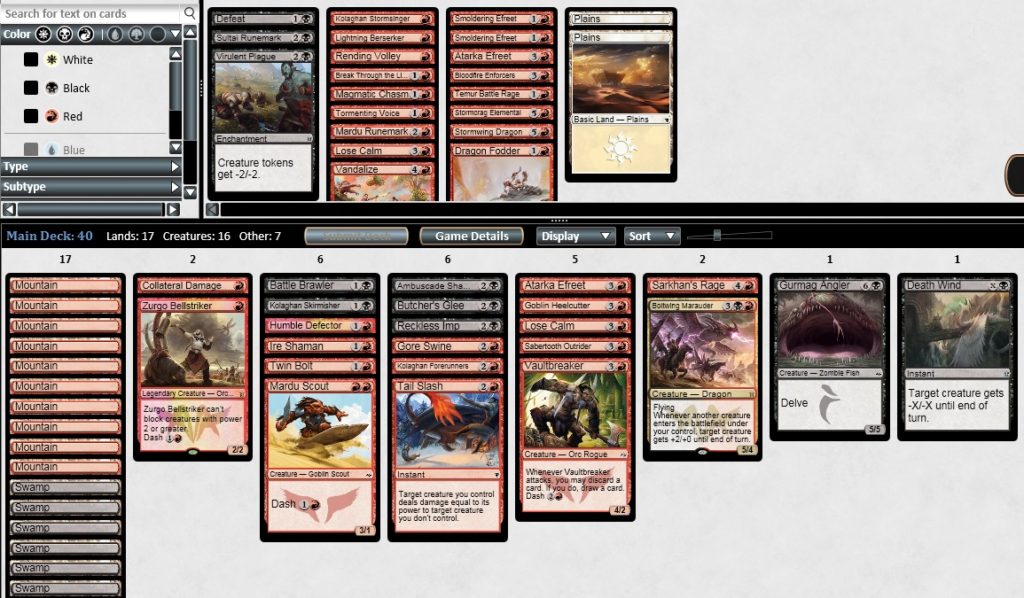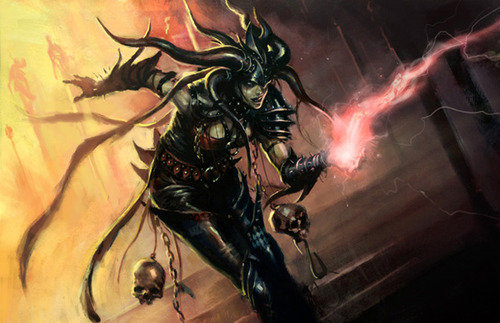I had a feeling red would be good in Dragons of Tarkir. It’s a set about dragons, right? Dragons are red. Red won’t suck. It can’t. That would make no sense. Everything Wizards does makes sense. They would never make a set called Dragons that lacks awesome red cards. Remember Rubblebelt Maaka? See, Q.E.D. It’s a neat syllogism.
Seriously though, red had to be powerful in Dragons of Tarkir limited. It was the worst color in Khans, so it had plenty of room to grow. Zurgo was really holding the color down with his smash this, obliterate that mentality. Now he’s ringing the bell and we all know—when the bell is ringing, things get serious.
Apparently the other folks in my release 8-4 draft the other night didn’t get the memo.
Red was, perhaps, a bit open in this draft. I had the pick of the litter in all three packs. There was even a Kolaghan Aspirant in pack one that wheeled back to me, but I passed it the second time to take Kolaghan Skirmisher instead. A 2/2 that can dash seems better than a 2/1 that Ashmouth Hounds on some blockers. And apparently I was correct that any number of red two drops would be available to me later.
It can be a real challenge to cut such a deep pool of cards down to 23 for the main deck. My guiding principle was that dash is a very powerful mechanic that provides incredible versatility to aggressive decks. So I should maximize the effectiveness of my dash cards. Here’s what I submitted:
Dash Brothers
The thing about dash is that you end up spending a lot of mana before you attack. That means you have less mana available to do other things, like cast combat tricks or flip megamorphs. I probably should have cut Butcher’s Glee for this reason, and in fact I sided it out every match. A dash deck doesn’t want to block, and it doesn’t really want to get blocked either. You go around, you go around fast, and you just don’t give a damn what is coming back at you.
This logic led me to cutting the expensive megamorphs. Stormcrag Elemental is a strong card, but this deck wants to make big creatures by dashing with an Ambuscade Shaman or Boltwing Marauder on board. When this deck spends three mana for a 2/2, it better have haste. Spending a pile to flip it into a big trampler or flier is too slow. It’s nice to have that option in the sideboard, if throwing mana at your opponent’s face ins’t working so well. But it turns out throwing mana at your opponent’s face works pretty well.
I went 3-0 and won the 8-4 without breaking a sweat. After dropping game one of the finals to being outraced by Great Teacher’s Decree, I regained my winning ways. Kolaghan Forerunners combos well with Boltwing Marauder. Who knew?
So what’s going on here? Dash is really mana-intensive and tempo-negative. How could it be the most powerful mechanic in the set? One word: flexibility. It’s not just for middle school fitness tests anymore! Cards that can do two things are better than cards that can do one thing. Magic games go in all sorts of directions, and the ability to change your strategy on a dime provides the opportunity to gain strategic edges.
Powerful constructed decks often exhibit hybrid characteristics. You hear aggro-control or combo-control spoken in reverent tones. Everyone wants to rub up with Splinter Twin in Modern. Standard Delver and Faeries weren’t the most objectively powerful decks in terms of card quality, but they were flexible. A strong player could figure out what needed to happen to win each game, and the deck had the tools to make it happen. It’s the Primal Clay archetype.
Dash does the same thing. Do you need a board presence? You can always cast your dash creatures like normal. Think of that as the backup mode of the card. But what if the dash cost is cheaper? Vaultbreaker hits hard on turn three into an empty board. Reckless Imp is like an enchantment that lets you pay two mana to Shock your opponent once a turn. Sprinting Warbrute is a four mana repeatable lava axe. These are efficient cards. Even when their regular casting mode is weak, it’s still an option that will sometimes be useful.
And the crazy thing is, dashing is not always a downside. Pacifism doesn’t do much to stop dash. Cards like Defeat could kill most cards in a dash deck, if they ever stay on the board during your opponent’s turn. Flamerush Rider never needs to get Roasted. One way to beat an aggro deck is to chain a ton of removal spells. Against dash, only instant kills will work, and constantly holding up mana to kill dash creatures prevents your opponent from developing their board. That makes your lack of blockers less of a problem. Butcher’s Glee felt bad for me because dash decks don’t need to gain life. Your opponent is afraid to attack, or can’t afford to.
If you want to succeed in Dragons of Tarkir draft, I recommend dashing. Feels the joy of holding three different dash creatures in hand. So many choices. What will you do? Win. What will your opponent do? Waste their mental energy figuring out how they can defend against all combinations of creatures you could throw at their face each turn. Dash makes your opponent sweat.
Watch the pro tour this weekend. Check out the draft tables. I bet you’ll see a lot of dashing on camera.
Carrie O’Hara is Editor-in-Chief of Hipsters of the Coast.



